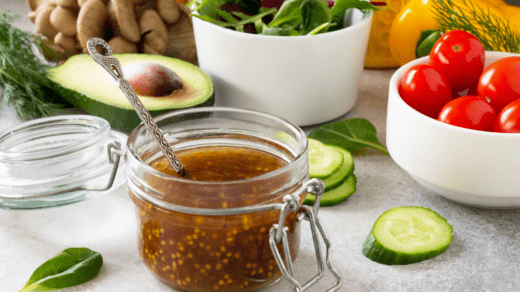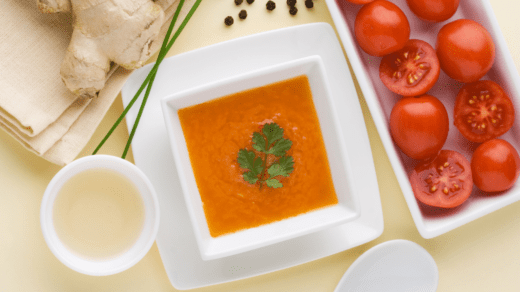Hey There! Some links on this page are affiliate links, which means that as an Amazon Associate, I may earn a small commission at no extra cost to you. I greatly appreciate your support! Learn more on my Affiliate Disclosure page.
Creating your lobster stock at home may seem like a daunting task, but it’s more achievable than you might think. With a few key ingredients and some simple steps, you’ll be able to craft a luxurious base that will make your taste buds dance with delight.
Whether you’re a seafood enthusiast looking to up your game or just someone eager to try something new in the kitchen, this guide by Chef Mark Sandoval will walk you through making a lobster stock that is truly extraordinary. Ready to dive in? Let’s get started!
Why You Will Love This Recipe

Making homemade lobster stock brings numerous benefits to your kitchen and cooking. From its rich, deep flavor to its versatility and health benefits, there are many reasons to incorporate this delicious stock into your culinary repertoire.
| Aspect | Description |
|---|---|
| Rich and Deep Flavor | The homemade lobster stock has an unparalleled depth of flavor. Roasting the lobster bodies and simmering with fresh vegetables and herbs ensures a rich, robust stock that enhances any dish, making your soups, stews, and sauces truly gourmet. |
| Versatility in the Kitchen | Lobster stock is incredibly versatile and can be used in various recipes. It offers endless possibilities and a fantastic base for creamy bisques, hearty chowders, delicate risottos, pasta dishes, paellas, and seafood stews. |
| Healthier and Fresher | Making lobster stock at home means you control the ingredients, avoiding preservatives and excess sodium found in store-bought versions. This results in a healthier, fresher stock that outshines anything from a can or box. |
| Cost-Effective | Homemade lobster stock maximizes seafood purchases by using leftover lobster bodies. It also stretches your grocery budget, reduces waste, and provides a high-quality ingredient to elevate your cooking without breaking the bank. |
| Customizable to Your Taste | You can customize your lobster stock to suit your preferences. Add extra parsley or basil for more herb flavor, a pinch of saffron for luxury, or a splash of white wine for acidity. This flexibility lets you tweak the recipe to fit your taste. |
| Impress Your Guests | Dishes made with homemade lobster stock will impress family and friends. The deep, rich flavor stands out, and knowing you made the stock from scratch adds culinary credibility, whether for special occasions or regular dinners. |
| Satisfying and Rewarding Process | Making lobster stock from scratch is satisfying. The process of roasting, simmering, and straining takes time and care but results in something flavorful and versatile. Plus, the aroma while it simmers is simply divine! |
Lobster Stock Ingredients

The key to a flavorful lobster stock lies in using fresh, high-quality ingredients. Each component adds its unique flavor and depth, contributing to the rich and savory taste of the final stock.
Below is a detailed list of the ingredients you’ll need, along with brief descriptions to help you understand their role in creating this delicious base for your recipes.
| Ingredient | Description |
|---|---|
| Lobster bodies | Provides a rich base flavor for the stock. |
| Mirepoix vegetables | Onion, celery, carrot, and leek – essential for a flavorful stock foundation. |
| Tomato paste | It adds a rich umami flavor. |
| Leek tops | Enhances the flavor of the stock. |
| Fennel fronds | Adds a subtle, sweet anise flavor. |
| Parsley | Fresh herb for added depth. |
| Basil | Adds a sweet and savory flavor. |
| Dill | Fresh herb for a hint of sweetness. |
| Cold water | The base liquid for the stock. |
| Blended oil | 75% canola, 25% extra virgin olive oil – for sautéing the vegetables. |
| White wine (optional) | Adds acidity and depth of flavor. |
| Saffron (optional) | Adds a unique flavor and vibrant color. |
Kitchen Tools You’ll Need

Having the right tools on hand makes the process of making lobster stock much smoother and more efficient. Each tool plays a crucial role in achieving the best results, from preparing the ingredients to simmering and straining the stock.
Below is a list of essential kitchen tools you’ll need to make your lobster stock, ensuring you’re well-prepared for every step.
| Tool | Description |
|---|---|
| Kitchen bowl | For holding chopped vegetables and lobster bodies. |
| Cutting board | Surface for chopping vegetables. |
| Chef’s knife | Essential for chopping ingredients. |
| Kitchen towels | For keeping the work area clean. |
| Peeler | For peeling vegetables. |
| Skimmer | To remove foam and impurities from the simmering stock. |
| Large stockpot | To cook and simmer the stock. |
| Chinois | Fine mesh strainer for straining the stock. |
| Baking sheets | For roasting lobster bodies. |
| Aluminum foil | To line the baking sheets. |
| Wire rack | For roasting lobster bodies. |
| Spatula | For stirring ingredients in the pot. |
| Kitchen spoon | For removing larger pieces from the pot. |
| Kitchen tongs | For handling hot lobster bodies. |
| Baking mittens | Optional for handling hot items safely. |
Step-By-Step Lobster Stock Instructions – VIDEO
1. Preparation:
- Gather all your ingredients and tools.
- Clean the lobster bodies by removing leftover meat and rinsing them under cold water.
2. Chop Vegetables:
- Use a chef’s knife on a cutting board to chop the mirepoix vegetables (onion, celery, carrot, and leek) into small pieces.
3. Roast Lobster Bodies:
- Preheat your oven to 400°F (200°C).
- Place the lobster bodies on a baking sheet lined with aluminum foil and a wire rack.
- Roast the lobster bodies in the oven for about 20-30 minutes until they are fragrant and slightly browned.
4. Sauté Vegetables:
- In a large stockpot, heat the blended oil over medium-high heat.
- Add the chopped mirepoix vegetables and sauté until softened and start caramelizing, for about 10 minutes.
- Stir in the tomato paste and cook for an additional 2-3 minutes.
5. Add Lobster Bodies and Herbs:
- Add the roasted lobster bodies to the pot.
- Add the leek tops, fennel fronds, parsley, basil, and dill.
- Pour in enough cold water to cover all the ingredients.
6. Optional Ingredients:
- If using, add white wine and a pinch of saffron to the pot.
7. Simmer:
- Bring the mixture to a boil, then reduce the heat and let it simmer for 2-3 hours.
- Skim off any foam or impurities that rise to the surface using a skimmer.
8. Strain the Stock:
- Once the stock has finished simmering, remove it from the heat.
- Use a spoon or a tong to remove the larger pieces from the pot.
- Strain the remaining liquid through a chinois or fine mesh strainer into a clean kitchen bowl.
9. Cool and Store:
- Allow the stock to cool to room temperature.
- Pour the cooled stock into storage containers and refrigerate or freeze until ready to use.
Tips, Tricks, and Storage Options

Creating a rich and flavorful lobster stock is not just about following the recipe. It’s also about employing key tips and tricks to take your stock from good to great.
Below, you’ll find valuable tips and tricks to enhance your stock-making process and effective storage options.
| Tip/Trick | Description |
|---|---|
| Roasting the Lobster Bodies | Roasting helps to develop a deeper, richer flavor in the stock. |
| Skimming the Foam | Regularly skimming the foam ensures a clearer, cleaner stock. |
Storage Options
| Storage Option | Description |
|---|---|
| Refrigeration | Store lobster stock in the refrigerator for up to 3 days. |
| Freezing | Freeze lobster stock for up to 3 months for longer storage. |
| Freezing Tip | Freeze the stock in ice cube trays for easy portioning and quick recipe use. |
Conclusion

Making lobster stock from scratch is a rewarding process that enhances the flavor of your soups, sauces, and seafood dishes. With these step-by-step instructions, you’ll have a rich and delicious stock that adds a gourmet touch to your recipes.
Try making your lobster stock and elevate your cooking! Share your results and tag us with #CookWithCem.
Thank you for reading! Be sure to check back soon for more informative and exciting articles.
Happy cooking!
FAQs – Frequently Asked Questions

Can I use other seafood instead of lobster?
Yes, you can use shrimp shells or crab bodies for a different but equally delicious seafood stock. Each type of seafood will bring its unique flavor profile to the stock, giving you a variety of options for your recipes.
What can I use the lobster stock for?
Lobster stock is perfect for enhancing bisques, chowders, risottos, and seafood stews with a rich and robust flavor. It can also be used as a flavorful base for pasta dishes and even as a cooking liquid for grains like rice and quinoa.
How can I store leftover stock?
Store the leftover lobster stock in airtight containers in the refrigerator for up to 3 days to maintain freshness. For longer storage, you can freeze the stock for up to 3 months without losing its rich flavor.
Can I skip roasting the lobster bodies?
Roasting the lobster bodies is recommended for developing a deeper flavor, but it can be skipped if you’re short on time. However, you might miss out on the extra richness and complexity that roasting brings to the stock.
Is white wine essential?
No, white wine is optional but adds a nice depth and subtle acidity to the stock. If you prefer, you can omit the wine or substitute it with a splash of apple cider vinegar or lemon juice for a different flavor profile.
How do I reheat frozen stock?
To reheat frozen lobster stock, thaw it overnight in the refrigerator or place the container in a bowl of warm water. Then, gently warm the stock on the stove over low heat until it reaches the desired temperature.
Can I use dried herbs instead of fresh ones?
Fresh herbs are preferred for their vibrant flavor, but dried herbs can be used in a pinch. When substituting, use about one-third of the amount called for fresh herbs, as dried herbs are more concentrated in flavor.
How long does it take to make lobster stock?
The preparation and cooking process for lobster stock typically takes about 3-4 hours. This includes the time needed for roasting, simmering, and straining the stock to achieve its rich and flavorful essence.
Is saffron necessary?
Saffron is not necessary but adds a unique flavor and vibrant color to the stock, making it more luxurious. If you don’t have saffron on hand, you can still make a delicious lobster stock without it.
Hey There! Some links on this page are affiliate links, which means that as an Amazon Associate, I may earn a small commission at no extra cost to you. I greatly appreciate your support! Learn more on my Affiliate Disclosure page.



























